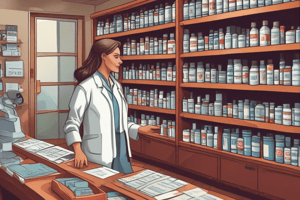Podcast
Questions and Answers
What should you do when preparing medication for a patient?
What should you do when preparing medication for a patient?
- Ask a colleague to double-check the medication order
- Skip checking the medication order against the original physician's order
- Prepare medication for one patient at a time (correct)
- Prepare medication for multiple patients at once to save time
What should you check against the original physician's order?
What should you check against the original physician's order?
- The medication order (correct)
- The patient's medical history
- The patient's name and identification
- The medication's expiration date
Why should you wash your hands and put on clean gloves?
Why should you wash your hands and put on clean gloves?
- To prevent medication contamination (correct)
- To impress the patient with your hygiene
- To show off your personal hygiene habits
- To make a good impression on colleagues
What should you do when calculating the correct dose?
What should you do when calculating the correct dose?
What should you do when checking the patient's medication?
What should you do when checking the patient's medication?
When should you check the drug label?
When should you check the drug label?
Why should you prepare and give drugs in well-lit areas?
Why should you prepare and give drugs in well-lit areas?
What should you do if you notice signs and symptoms of toxicity?
What should you do if you notice signs and symptoms of toxicity?
Why should you identify the patient and yourself (if indicated)?
Why should you identify the patient and yourself (if indicated)?
What should you do with prepared medications at the patient's bedside?
What should you do with prepared medications at the patient's bedside?
Flashcards are hidden until you start studying
Study Notes
Preparing Medications
- Prepare medication for one patient at a time to avoid mix-ups.
- Check each medication order against the original physician's order or MAR to ensure accuracy.
- Prepare medication card and check rights, including patient's name, medication, and dosage.
- Prepare needed supplies and equipment, such as clean gloves and a calculator.
- Read the label on the drug container, noting the name, strength, supplies dose, expiration date, and clarity of the solution.
Administration Techniques
- Wash hands and put on clean gloves to maintain sterility.
- Calculate correct dose, taking into account drug concentrations and patient needs.
- Use sterile technique in preparing and administering injections to prevent contamination.
- Do not leave any prepared medications at the patient's bedside to avoid mistaken identity.
Patient Safety
- Identify the patient and yourself, if necessary, to ensure correct administration.
- Explain the procedure to the patient, including the medication and its effects.
- Check for drug allergies and contraindications to prevent adverse reactions.
- Do not give a drug when signs and symptoms of toxicity are present.
Label Verification
- Check label THREE TIMES: when reaching for the medication, just before placing medication in cups, and when returning the medication to the place of keeping.
- Verify the name, strength, supplies dose, expiration date, and clarity of the solution each time.
Environmental Considerations
- Prepare and give drugs in well-lit areas, free of interruptions and distractions, to minimize errors.
- Keep the patient's privacy during the administration process.
- Assist the patient to a comfortable position to facilitate administration.
Documentation and Follow-up
- Document medication: dosage, route, site, time, and signature.
- Evaluate the patient's response to the medication within an appropriate time frame.
- Return to observe the patient for signs of a local or systemic reaction.
Prevention of Errors
- Check orders for accuracy and clarity.
- Clarify illegible orders to prevent mistakes.
- Check blood pressure, pulse, and lab results before administration.
- Check calculations to ensure accurate dosing.
Studying That Suits You
Use AI to generate personalized quizzes and flashcards to suit your learning preferences.




